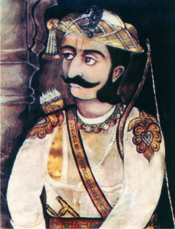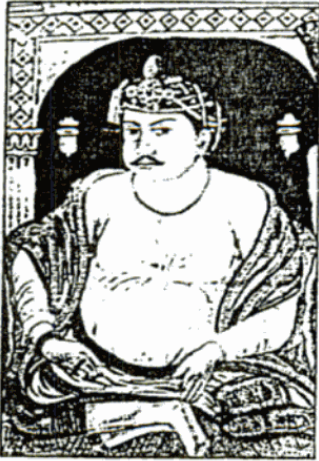
Gondwana, also known as Gondaranya, is a region of India, named after the Gondi people who live there. The name of the ancient continent of Gondwanaland was derived from Gondwana, because some of the earliest rock formations of this continent were first investigated in part of the region, in modern Odisha.

Vidarbha is a geographical region in the east of the Indian state of Maharashtra and a proposed state of western India, comprising the state's Amravati and Nagpur divisions. Amravati Division's former name is Berar. It occupies 31.6% of the total area and holds 21.3% of the total population of Maharashtra. It borders the state of Madhya Pradesh to the north, Chhattisgarh to the east, Telangana to the south and Marathwada and Uttar Maharashtra regions of Maharashtra to the west. Situated in central India. The largest city in Vidarbha is Nagpur followed by Amravati, Akola, Chandrapur and Gondia. A majority of Vidarbha residents speak Varhadi and Zadi dialects of Marathi.

Chandrapur is a city and a municipal corporation in Chandrapur district, Maharashtra state, India. It is the district headquarters of Chandrapur district. Chandrapur is a fort city founded by Khandkya Ballal Sah, a Gond king of the 13th century. The city sits at the confluence of the Erai river and Zarpat river. The area around the city is rich in coal seams.. Hence, Chandrapur is also known as the "Black Gold City".
Gadchiroli is a city and a municipal council in Gadchiroli district in the state of Maharashtra, central India. It is located on eastern side of Maharashtra, and is the administrative headquarters of the district. Gadchiroli is called a lung of Maharashtra as it has almost 35% of this district has forest cover. The main river flowing through city is the Wainganga River. The landscape is lush and green during the monsoon season which is prone to flooding. Gadchiroli is known for its forests. Teak is grown commercially and bamboos are used for various crafts.
Manikgad / is an ancient fort in Chandrapur district, Maharashtra. It is a hill fort 507 metres above sea level built by the Naga kings in 9 CE. The fort is in ruins and is frequented by wild animals that live in the vicinity, such as panthers and boars. Several monuments of historical importance are nearby.

The Kingdom of Nagpur was an Indian kingdom in the 18th and 19th centuries. It came under the rule of the Marathas of the Bhonsle dynasty in the mid-18th century and became part of the Maratha Empire. The city of Nagpur was the capital of the state.

Bhadravati is a city and a municipal council in Chandrapur district in the state of Maharashtra, India. It lies 26 km from Chandrapur city. Bhadravati city has recently bagged the Best City in 'Innovation & Best Practices' award under the population Category - 50K to 1 Lakh from the Government of India under Swach Surverkshan Awards-2021. It has also bagged 8th Rank in being the cleanest city under category population Category - 50K to 1 Lakh under Swach Surverkshan Awards-2021 amongst 132 cities nominated.

Raghoji I or Raghuji the Great of the Bhonsale dynasty, was a Maratha general who took control of the Nagpur Kingdom in east-central India during the reign of Shahu I. His successors ruled the kingdom until 1853.
Gondwana was a kingdom that ruled over the Gondwana region of India. The Gondwana region includes eastern Vidarbha, Maharashtra, parts of Madhya Pradesh, and western Chhattisgarh. Kingdom of Gondwana was ruled by Rajgonds.Rajgonds. The Rajgonds are the ruling class of the Gonds. Gondwana named after the Gondhi tribe. The Gonds dominate the Gondwana community. The early Kingdom of Gondwana consisted of fallow kingdoms. South was Chanda Kingdom of Chandrapur and North Gondwana was Garha Katanga or Garhamandra Kingdom of Jabalpur. Devgar Kingdom of Chindwala Rise as a powerful kingdom in the 16th century, with the Hela Kingdom of Betul in its western past. Between the 14th and 18th centuries, the area was held by the powerful Gond dynasty. The Gond dynasty maintained its independence or served as a tributary chieftain during the Mughal Empire. Gond was first mentioned in his 14th-century Muslim chronicle. Rani Durgavati – Rani Durgavati of Gond defended his kingdom from Mughal forces. In 1556 AD, Baz Bahadur, Sultan of Marwa, attacked the kingdom of Rani Durgavati, but Rani successfully defended it. In 1564 Durgavat was attacked and defeated by Akbar's commander Asaph his khan. Her tomb is a witness to this brave queen. Wounded in her fight, rather than submit to her enemies, she stabs herself. The area larger than stretches over northern Telangana, western Orissa and parts of Uttar her southern Pradesh. Rani Kamlapati-Ginnor was considered an impregnable fortress perched atop a sheer 2000 foot cliff and surrounded by dense forest. Also, the area around the Upper Lake of Bhopal was mainly (1710s) Bir and inhabited by the Gond tribe. Nizam Shah, the mightiest warlord of the Gond region, who ruled his realm from the fortress of Zinore. Ranikamlapati was one of his seven wives of Nizamshah. Kamlapati, famous for her beauty and talent. A local legend describes it more beautifully than Paris. Nizam Shah was poisoned by his nephew his Alam Shah, his Raja Chainpur-Bariand, who wanted to marry Kamlapati. Kamlapati offered Dost Mohammad Khan 100,000 rupees to protect her honor, protect her kingdom, and avenge her husband's death. Mohammad Khan led a combined army of Afghan and Gond soldiers who defeated and killed Alam Shah. Khan accepted the offer and Kamlapati also tied a rakhi in his hand. The kingdom was incorporated into the Kingdom of Kamlapati in place of the remaining kingdoms. Rani didn't have 100,000 rupees, so she paid him half the amount and gave the village to Bhopal. Rani Kamlapathi committed suicide near his palace in 1723 and Dost initially ruled the Ginoor Fort, loyal to Rani's son Nawal Shah, who was invited to live in the fort. disguised as Mohammad Khan disguised his 100 soldiers as women and sent them to Zinore and Doris to house his wife.
Ajanbahu Jatbasha is considered by historians to be founder of the Gond dynasty of Chhindwara and Nagpur, which ruled the present days territories of Madhya Pradesh, Chhattisgarh and part of Maharashtra in the 16th-18th centuries. Documentation of his origins and rise to power have not survived, but he is the first historical leader of the mountain Gondi people.

Bakht Buland Shah was a ruler of the Rajgond dynasty. He added to his kingdom, the territories of Chanda and Mandla, and portions of Nagpur, Balaghat, Seoni, Bhandara and the adjoining Rajput kingdom of Kherla/Khedla. The present districts of Chhindwara and Betul also fell under his control. A great warrior, he went on to conquer Pauni, Dongartal, Sivni & Katangi.
Gondwana Kingdom was the ruling kingdom in Gondwana region of India. The Gondwana region includes core region of eastern part of the Vidarbha of Maharashtra, Garha Kingdom the parts of Madhya Pradesh immediately to the north of it, and parts of the west of Chhattisgarh. The wider region extends beyond these, also including parts of northern Telangana, western Odisha and southern Uttar Pradesh.

Vairagad is a small fort situated in the Gadchiroli district of Maharashtra, India, at the confluence of rivers Khobragadhi and Satnalas. The small dusty village of same name is adjacent to the fort. The fort is situated 180 km from Nagpur and 80 km from Chandrapur.
Ballarpur Fort is an ancient fort in Chandrapur district, Maharashtra, India. It is located in the Ballarpur city, on the east banks of the Wardha River.

The Bhonsles of Nagpur were a Maratha royal house that ruled the Kingdom of Nagpur from 1739-1853. They hailed from the Bhonsle clan of Marathas and were one of the most important and powerful Maratha chiefs in the Maratha Empire.

The Gonds of Deogarh were a Gond royal house that founded and ruled the Nagpur Kingdom before being practically being made state pensionaries by the Bhonsle Maratha leader Raghoji I Bhonsle. They made Nagpur a prosperous and plentiful kingdom, founding the city of Nagpur and building further infrastructure. However, internal bickering led to their downfall.
Raghunath Singh was the Diwan of the Gond king of Deogarh. He tried to unsuccessfully overthrow Raghuji Bhonsla's sway with the help of the Gond king of Chandrapur, Nilkanth Shah.
The siege of Nagpur was laid by Khan-i-Dauran, a high-ranking Mughal official to the fort of Nagpur, ruled by the Gond king of Deogarh, Kok Shah.
The Kingdom of Chanda was one of the main Gond kingdoms, ruling parts of central India. In 1751, it was conquered by the Maratha ruler of Nagpur, Raghoji I Bhonsle.
Baka Bai was a Maratha stateswoman and favourite wife of Raghoji II Bhonsle, the king of Nagpur. After her husband's death, she played a key role in the intrigues at the royal court of Nagpur.








